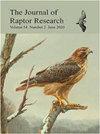Nest Usurpation by a Female Mississippi Kite (Ictinia mississippiensis)
IF 1.2
4区 生物学
Q2 ORNITHOLOGY
引用次数: 0
Abstract
Virtually all species compete for resources, which can lead to aggressive intraand interspecific interactions between individuals (Scott and Fredericson 1951). These interactions may take the form of displays, aggressive chases, and physical contacts (Jamieson and Seymour 1983, Bildstein and Collopy 1985, Boal 2001). Among conspecifics, these interactions may be agonistic, which is an escalation of behaviors from threat displays (often ritualized) to aggression, ultimately resulting in the submission or death of one combatant (McGlone 1986). For example, territorial Harris’s Hawks (Parabuteo unicinctus) engage in posturing, display, and eventual attack if an intruding conspecific does not leave (Dawson and Mannan 1991). In more extreme cases, individuals may kill and cannibalize conspecifics (Allen et al. 2020). The Mississippi Kite (Ictinia mississippiensis) is a highly social, quasi-colonial species (Skipper 2018, Parker 2020). For example, in 2022 I monitored 52 nests among 20 urban parks (one to eight nests/ park) in Lubbock, Texas, USA, and documented a mean density of one nesting pair per 2.7 ha (62.46 SD). Additionally, large nonbreeding groups may communally roost in trees near occupied nests. Despite such close proximities, aggressive interactions between Mississippi Kites appear to be exceedingly rare, with only a few documented events that usually consist of adults chasing subadults away from nests (Shaw 1985, Parker 2020). In summer 2020, I banded a nesting female Mississippi Kite with a US Geological Survey Bird Banding Lab aluminum leg band and a plastic green-colored band with the white letters ME (hereafter G-ME). I did not band the male of the breeding pair. The pair’s 2020 nesting attempt was successful in fledging one young. On 4 June 2021, I confirmed the female G-ME had returned to the 2020 nest area. The 2020 nest had blown out, but the kites had constructed a new nest and I observed multiple copulations between an unbanded male and G-ME. On 23 June 2021 at approximately 1020 H CST, I approached the G-ME nest to assess breeding status. At this date, all the monitored kite nests in my study were in the incubation stage. Upon my arrival I observed G-ME standing on the north side of the nest and facing an unbanded adult female Mississippi Kite perched in the cup of the nest (Fig. 1). The two kites posed with gaped beaks, nape feathers erected, and wings flared out as they faced each other. An unbanded adult male was perched on a branch approximately 1 m above and to the side of the nest. Although I did not know when the interaction was initiated, I watched for more than 10 min as the two female kites commenced to fight on the nest. They began making pecking strikes at each other, progressing to breast to breast contact and batting at each other with their wings and making pecking strikes toward each other’s faces (Supplemental Material 1). When one bird struck out with its beak, the other would retract its head backward to avoid the strike. This back-and-forth sparring continued for several minutes until the一只密西西比鸢(Ictinia密西西比)侵占巢
几乎所有物种都在争夺资源,这可能导致个体之间具有侵略性的种内和种间相互作用(Scott和Fredericson, 1951)。这些互动可能以展示、攻击性追逐和身体接触的形式出现(Jamieson and Seymour 1983, Bildstein and Collopy 1985, Boal 2001)。在同种个体中,这些相互作用可能是敌对的,这是一种从威胁表现(通常是仪式化的)到攻击的行为升级,最终导致一个战斗员的屈服或死亡(McGlone 1986)。例如,具有领土意识的哈里斯鹰(Parabuteo unicinctus)会在入侵的同种动物不离开的情况下做出姿态、展示,并最终发起攻击(Dawson and Mannan 1991)。在更极端的情况下,个体可能会杀死并同类相食(Allen et al. 2020)。密西西比风筝(Ictinia密西西比)是一种高度社会化的准殖民地物种(Skipper 2018, Parker 2020)。例如,在2022年,我监测了美国德克萨斯州拉伯克市20个城市公园(1至8个鸟巢/公园)中的52个鸟巢,并记录了每2.7公顷(62.46 SD)一对鸟巢的平均密度。此外,大型非繁殖群体可能在被占领的巢穴附近的树上共同栖息。尽管距离如此之近,但密西西比鸢之间的攻击性互动似乎非常罕见,只有少数记录在案的事件通常是成虫将亚成虫从巢穴中赶走(Shaw 1985, Parker 2020)。在2020年夏天,我用美国地质调查局鸟类绑带实验室的铝腿带和带有白色字母ME(以下简称G-ME)的绿色塑料带捆绑了一只筑巢的雌性密西西比风筝。我没有给交配对中的雄性戴上手铐。这对夫妇在2020年的筑巢尝试成功地孵出了一只幼崽。2021年6月4日,我确认雌性G-ME已经回到2020年的巢穴区域。2020年的鸟巢已经被吹灭了,但风筝已经建造了一个新的鸟巢,我观察到一只没有绑带的雄性和G-ME之间进行了多次交配。2021年6月23日大约1020时,我走近G-ME巢穴,评估繁殖状况。此时,我所监测的所有风筝巢都处于孵化阶段。当我到达时,我观察到G-ME站在鸟巢的北侧,面对着一只未带的成年雌性密西西比风筝,它栖息在鸟巢的杯子里(图1)。两只风筝张开嘴,竖起后羽,翅膀张开,面对着对方。一只没有系带的成年雄性栖息在鸟巢上方约1米的树枝上。虽然我不知道互动是什么时候开始的,但我看了十多分钟,两只雌风筝开始在鸟巢里打架。它们开始互相啄击,发展到胸对胸接触,用翅膀互相拍打,对着对方的脸进行啄击(补充材料1)。当一只鸟用喙击打对方时,另一只鸟会缩回头以躲避攻击。这种来回的争吵持续了几分钟,直到
本文章由计算机程序翻译,如有差异,请以英文原文为准。
求助全文
约1分钟内获得全文
求助全文
来源期刊

Journal of Raptor Research
生物-鸟类学
CiteScore
2.30
自引率
17.60%
发文量
61
审稿时长
>12 weeks
期刊介绍:
The Journal of Raptor Research (JRR) is an international scientific journal dedicated entirely to the dissemination of information about birds of prey. Established in 1967, JRR has published peer-reviewed research on raptor ecology, behavior, life history, conservation, and techniques. JRR is available quarterly to members in electronic and paper format.
 求助内容:
求助内容: 应助结果提醒方式:
应助结果提醒方式:


